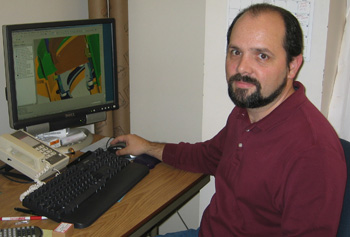Meet the IBEX Team: John Nolin

John Nolin has been interested in space and engineering all his life. "When I was 10 or 11, I wrote a letter to NASA, and they sent back an entire package of posters, brochures, and papers," he said.
Watching his father, a mechanical engineer, work on drafting at their home in Pelham, New Hampshire first ignited John's interest in mechanical engineering. "My father worked for the local defense sub-contractor, and there were always issues of Popular Mechanics around the house. I just always thought that mechanical engineering and new technology were interesting."
When he was a child, John hoped to become an astronaut or a car designer. "Now I design space satellite instrumentation, which is not a bad mix of the two," he said.
As a research project engineer at the University of New Hampshire's Institute for the Study of Earth, Oceans, and Space, John designs and assembles the entrance systems for the IBEX-Hi and IBEX-Lo sensors. The entrance systems are made of three main parts: the collimators, electron rejection rings, and sunshades. These parts work together to let in particles that the scientists want to study, and to block the particles that don't interest them.
John explained the specifics of the entrance system. "The rejection rings push away the particles we don't want. They're powered at -4000 volts so that any electron of that energy or less gets pushed away, kind of like magnets. The sunshades are to keep direct sunlight out of the opening of the collimator. The collimator sits on the sensor base plate, below the rejection rings and sunshades, and acts like a screen, only letting through the particles that are in the prescribed field of view."
In the last month, John has been assembling the IBEX-Hi and -Lo collimators. "We have a clean room right here in the lab, and we put on the funny suits and get in the clean room and stack things one by one. That's what's different about the university - you build what you design," John said.
Putting the collimators together can be challenging. "The individual pieces are very delicate, and we have to come up with neat little tools for handling them. It gets to be quite an involved process. Each piece has to be carefully examined for cleanliness, and the individual pieces are whisper thin and very delicate. However, once they're together, they are very tight," he said.
As a research project engineer, John spends half his time doing mechanical computer aided drafting (CAD) and other design engineering work. The rest of the time, he assembles the things he designs or prepares them for testing. "The time spent on each task changes over the life of the project, which keeps things interesting," John said.
John enjoys the work. "I hope to continue what I am doing for a good long time, and eventually learn enough to understand everything the physicists are discussing instead of just a percentage," he said. The best part of his job is "working on this entirely unique instrumentation while being within a team that is thoroughly encouraging and supportive." On the opposite end of things, he says that the worst part of his job happens "when the CAD software crashes during the modeling of an intricate part!"
Before taking the position at the University, John worked as a mechanical engineer for a variety of firms and industries. He designed infrared optics, broadcast antennas, and worked as a product specialist for an MCAD software company. He sees a difference between working for for-profit companies and the non-profit University. "The environment is a lot nicer. For instance there's a chamber music concert in the atrium right now. That's something that doesn't happen at a business park," he said.
John first became interested in working at the University of New Hampshire Earth, Oceans, and Space Institute on an American Society of Mechanical Engineers-sponsored tour over ten years ago. "Mark Granoff gave a tour of this lab that I'm sitting in now. He was describing the challenges associated with putting satellites on rockets, and of designing sensitive equipment to go on a not-so-sensitive rocket ride. I thought it was really interesting. Fortunately, I kept an eye on the university postings and happened to be ready to change fields when the opening came up this time," he said.
Now that he works on space missions, John's image of NASA has changed. "NASA is much more than space shuttles and planetary probes. IBEX is part of whole range of scientific projects and missions that most of the public never hears about," John said.
When he is not working on the IBEX project, John enjoys computers, cycling, skiing, and working on home improvement projects. He's also been thinking up preliminary plans for a new space mission. "I have a rough idea for an exploration project that would involve some of the technology from my alma mater, the University of Massachusetts Lowell, and my employer, the University of New Hampshire. I don't know if it would make sense for the physicists, but I hope that it goes forward someday."
John offers specific advice for anyone who would like to follow in his footsteps by pursuing an engineering career. "Take your studies seriously, even the ones that are not always that interesting. Learning how to learn and work quickly and efficiently can be nearly as important to your future career as the subject matter in any particular class. Another important thing is to do a co-op or an internship. Get some form of experience, even if it's just one winter break - it makes a tremendous difference."
His final advice for potential engineers can apply to any career. "Challenging or interesting work and a pleasant environment will eventually be more important to you than a good paycheck. Look for these qualities in any potential employer, and be prepared to continue learning as you go."
